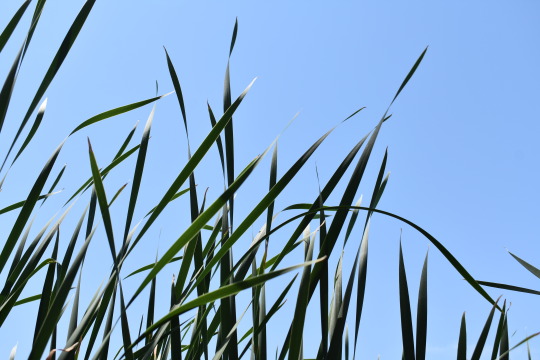#Typhaceae family
Explore tagged Tumblr posts
Text

Bullrushes sketch | Limited edition fine art print from an original drawing. Typha is a genus of about 30 species of monocotyledonous flowering plants in the family Typhaceae. These plants have a variety of common names, in British English as bulrush or reedmace, in American My sketches start life as hand-drawn graphite images made on cartridge paper. I often work on these with charcoal, oil pastel or Caran d'Ache to create the look I'm after. The artwork is then scanned and finessed digitally ready for fine art printing. This process often referred to as Giclée printing uses the highest standard of printing methods to give gallery quality results that maintain all the details of the original sketch. The graphite pencils I use are Faber-Castel, the oil pastels are Sennelier and the china-graph is Caran d’Ache. The inks are pigment based archive quality (100years+). The heavyweight specialist papers I use are of the best professional quality having a wonderful surface designed specifically for fine art drawings and illustrations. Very limited editions with only ten per size printed. All artwork is signed and includes a certificate of authenticity. The A5 are 5.8" x 8.25" (14.8cm x 21cm) The A4 are 8.25" x 11.7" (21cm x 29.8cm) The A3 are 11.7" x 16.5" (29.8 cm x 42cm) The A2 are 16.5" x 23.4" (42 cm x 59.4cm) Frames not included in price. Free shipping on artwork to UK destinations.
#variable#BlackandWhite#Flora#art#Bullrushes#drawing#gicleé#illustration#print#seanbriggs#sketch#A5#A4#A3#A2#Original
0 notes
Text
cattail
Typha /ˈtaɪfə/ is a genus of about 30 species of monocotyledonous flowering plants in the family Typhaceae. These plants have a variety of common names, in British English as bulrush or reedmace,[2] in American English as reed, cattail,[3] or punks, in Australia as cumbungi or bulrush, in Canada as bulrush or cattail, and in New Zealand as raupo. Other taxa of plants may be known as bulrush, including some sedges in Scirpus and related genera.
The genus is largely distributed in the Northern Hemisphere, where it is found in a variety of wetland habitats.
The rhizomes are edible, though at least some species are known to accumulate toxins and so must first undergo treatment before being eaten.[4] Evidence of preserved starch grains on grinding stones suggests they were already eaten in Europe 30,000 years ago.[5]
0 notes
Photo


Cattail Leaves Typha sp. Typhaceae Family
Photographs taken on July 15, 2020, at Rattray Marsh Conservation Area, Mississauga, Ontario, Canada.
#wildflowers of southern ontario#cattail#cattail leaves#Typhaceae#Typhaceae family#typha#xx#july#Rattray Marsh#rattray marsh conservation area#mississauga#ontario#canada#plants#plantblr#nature
17 notes
·
View notes
Text
ive talked about this on here before in relation to asian pitcher plants but i was talking to a phd student at a virtual mixer last night who studies cattails in the US and she said that some hybrid populations of them have had so much sex with so many different cattail species including their initial pre-hybrid species that it’s impossible to know which species they’re descended from or what they are without genetic testing. she also said that (unlike asian pitcher plants to my knowledge) some of these hybrids are so strong they’re actively contributing to the declining numbers of native cattail species because they start outcompeting them for resources. never forget plants could be committing sex-related acts of dangerous hubris as close as your backyard
#when will the madness end???#throwback to when they were teaching us about typhaceae (the cattail family) in plant systematics#and they were just like 'these are cattails. not all of them are horrible but many of them are. just look at them' *invasive cattail map*#botany 2020 liveblog
478 notes
·
View notes
Text
Eraka (Typha elephantina) - Uses, Dose, Side Effects, Research
Eraka (Typha elephantina) – Uses, Dose, Side Effects, Research

Eraka (Typha elephantina) is an Ayurvedic medicine used to treat urine retention, dysuria, renal calculus, burning sensation, bleeding disorders, wounds etc. Gundra (Typha angustata) and Eraka (Typha elephantina) belongs to different species of same family.
Botanical Name – Typha elephantina Family – Typhaceae
Indications of Eraka Mutrakrichra – difficulty in passing urine (dysuria), urine…
View On WordPress
0 notes
Text
Cattails:
Latin name: Typha latifolia Family: Typhaceae
I’m not great at exploring nature. When I see cattails poking out of a ditch or near a bit of protected natural space, my first thought is about snakes hiding underneath them. Here in the Pacific Northwest, we are blessed with a lack of poisounous snakes, but nonetheless my brain is convinced they must be hiding everywhere - especially on the edges of watery places where cattails live.
The brown fuzzy part of the stem is the female flower, which is topped with a male flower. I’ve personally never seen the male flowers, and had no idea that there were any. The female flower sticks around for months at a time, then disintigrates into thousands of tiny seeds.
The cattail stalks look so thin that it doesn’t seem like they should be able to support the weight of a bird, yet red winged blackbirds have absolutely no problem landing on them and performing acrobatics above the water. Cattails provide home and shelter to a number of species, wrens, shorebirds, amphibians, and the muskrat. Humans have also used this plant for a long time for medicine, food, and weaving materials.
This is a good plant to study if you live in the USA or Canada, because it shows up pretty much everywhere. And if you’d like to decorate with it, simply cut it down when it’s young and the seeds haven’t started to fluff up. Then you can coat it with hairspray and put it wherever.
0 notes
Photo




Typha is a genus of about 30 species of monocotyledonous flowering plants in the family Typhaceae. Typha are aquatic or semi-aquatic, rhizomatous, herbaceous perennial plants. The leaves are glabrous (hairless), linear, alternate and mostly basal on a simple, jointless stem that bears the flowering spikes. The plants are monoecious, with unisexual flowers that develop in dense racemes. The numerous male flowers form a narrow spike at the top of the vertical stem. Each male (staminate) flower is reduced to a pair of stamens and hairs, and withers once the pollen is shed. Large numbers of tiny female flowers form a dense, sausage-shaped spike on the stem below the male spike. In larger species this can be up to 30 centimetres (12 in) long and 1 to 4 centimetres (0.4 to 2 in) thick. The seeds are minute, 0.2 millimetres (0.008 in) long, and attached to fine hairs. When ripe, the heads disintegrate into a cottony fluff from which the seeds disperse by wind. These plants are edible and can be made into soup.
0 notes
Note
corn is......grass....????????
im???????
you know it!!! even better, bamboos are grasses, too, although (and i mention this because they’re relatively well known plants that give off strong grass vibes) cattails aren’t grass and actually form a family of their own (family name ‘typhaceae’). the technical grass family name is ‘poaceae’, if you feel compelled to go down that rabbithole, lmao.
the grass family is huge. not the biggest plant family in terms of species, but def one that’s found how to operate in any and all situations and habitats. also, grass has a lot of sex to the point where its notoriously hard to identify some grasses (usually ones that are more closely related to one another) because they’re just...having too much sex, and who knows who the parents were, not to mention that there’s not a whole lot of identifying features to go off of to begin with.
#it's the nepenthes problem all over again but wind pollinated this time#cursed plant sex gradients#asks#plant systematics#plont asks#Anonymous
1K notes
·
View notes
Text
Gundra (Typha angustata) - Uses, Actions, Side Effects, Research
Gundra (Typha angustata) – Uses, Actions, Side Effects, Research

By Dr Renita D’Souza Gundra (Typha angustata) is an Ayurvedic herb used to treat bleeding disorders, difficulty to pass urine. It detoxifies breast milk, semen, ovum, menstrual blood and urine. It acts as diuretic and heamostatic.
Botanical Name – Typha angustata Family – Typhaceae Synonyms – Typha angustifolia, Typha bracteata
Therapeutic Effects of Gundra
Stanya shodana – cleanses…
View On WordPress
0 notes